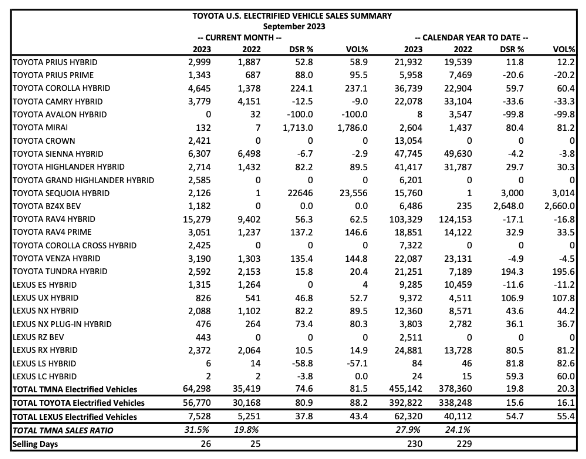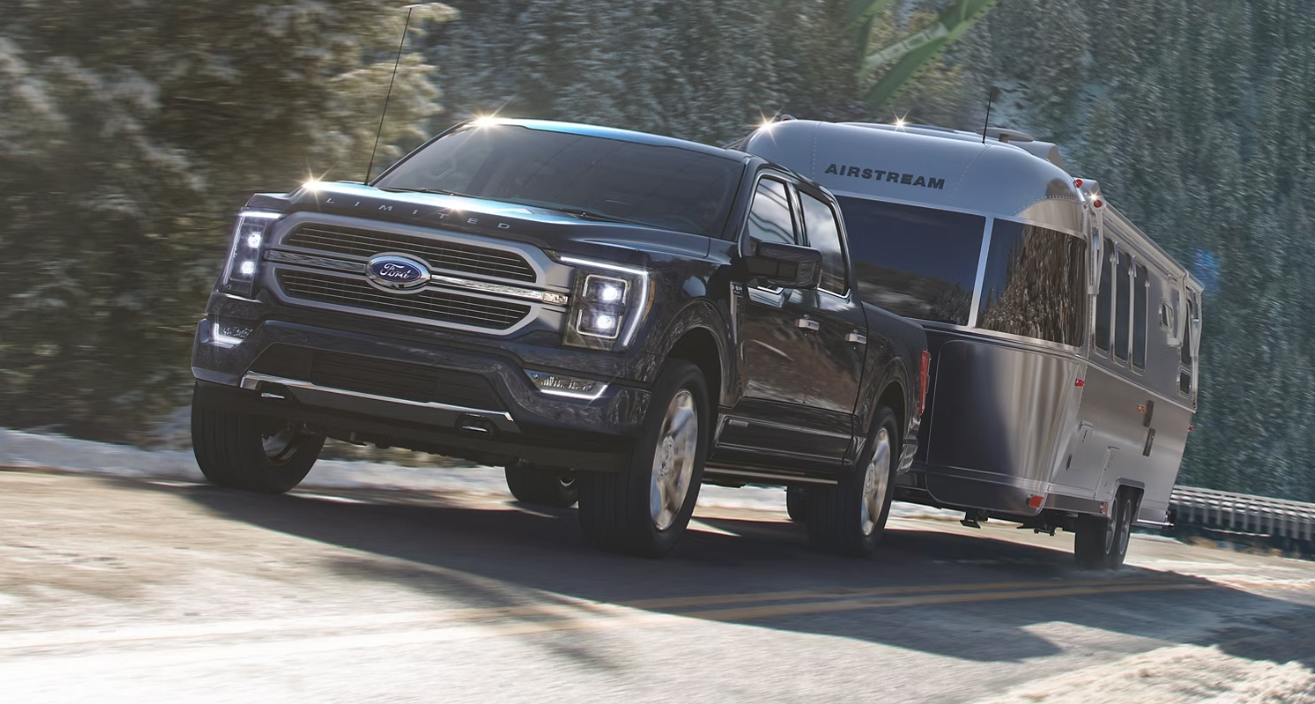Data from multiple sources are pointing to increasing average new vehicle prices for hybrids, while electric vehicles are now selling at 20% lower average prices than a year ago. Interestingly, the reasons for the increase in hybrid prices and decrease in electric vehicle prices are not the same, although all of the evidence points towards hybrids seeing an increase in popularity among both buyers and automakers.
KBB/Cox Automotive Say Hybrid Prices Are Up 41% From a Year Ago
One data point that caught our attention was from Kelley Blue Book / Cox Automotive. This group’s research shows that from October 2022 to October 2023, the average price of its Hybrid/Alternative Fuel vehicle segment rose from $34,087 to $48,096. That’s a 41% increase. Much of the increase came from September to October 2023. Meaning the average price increases accelerated in the current quarter which started in October 2023.
The mix of vehicles accounts for the bulk of this increase in the average price, not higher prices for existing hybrid models. Toyota, the global leader in electrified vehicles and the dominant player in hybrids, has moved to make hybrids standard on important models with high price points, like the Sienna minivan, and to offer hybrid powertrains, in some cases two different hybrid powertrains, on other high-price vehicles such as the Tundra and Tacoma pickups.
The legendary Prius is not going away. On the contrary, deliveries of the Prius are up by double digits year over year, and the Prius remains one of the top-selling car models in America. The Prius family was completely redesigned and is now much sportier and has a new style most reviewers consider quite pleasing to the eye. The Lexus side of the Toyota family has been hybridizing models as well and even offers hybrid sports car models. The all-new Toyota Grand Highlander and Lexus TX three-row SUVs will offer multiple hybrid powertrain offerings, and the top trims are all hybrids. This is the continuation of the hybridization trend for Toyota and Lexus.

Honda’s newest redesigns and concept vehicles are also focused on hybrids. And more importantly, Honda is building and delivering many more hybrids as a percentage of total deliveries. Vehicles like the CR-V, and Accord are now being produced in an approximately 50-50 split of hybrid and non-hybrid powertrains. Ford, too, is looking closely at boosting the sales of its F-150 Hybrid, which, during our real-world analysis, offered a lower cost of energy per mile driven than the Lightning battery-electric pickup when operated in EV-friendly Metro Boston.
A combination of the top trims of existing models being hybridized and new, more expensive models such as the F-150, TX, and Grand Highlander point the way to a higher average price point for hybrids. Notice that we have not mentioned that the prices of the legacy models are responsible. If there is any evidence that high-volume hybrids like the RAV4 Hybrid, Highlander Hybrid, Sienna, and Prius are selling at meaningful higher price points than a year ago, we can’t uncover it.

Planetizen Says - Hybrids Are Gaining Popularity
The publication Planetizen says “Hybrids Regain in Popularity Amid EV Cost and and Charging Concerns.” Backing up this claim are facts from GlobalData. These include:
-US sales of hybrids have more than doubled since 2020 and are heading toward a 35% increase this year.
-Ford aims to quadruple hybrid sales over the next five years and offer the technology across its lineup, even as it throttles back ambitious production plans for its fully electric models.
-The number of hybrid models for sale in the US market is expected to grow to 369 by 2026, more than double the 164 on sale in the US in 2020, according to GlobalData.
Bloomberg Business Week Says - America’s High EV Costs Are Driving Buyers to Hybrids
In an October story, Bloomberg lays out the case that consumers consider electric vehicles to be too expensive. You can read the story and its conclusion, but it matches our own. While EVangelists often claim that battery-electric vehicles offer a lower cost of ownership versus similarly-sized vehicles with other powertrains, the comparison is often to old-school gas models. Hybrids offer regenerative braking (which prolongs brake life) and also have a much simpler maintenance schedule. Battery-electric vehicles often have higher tire costs than hybrids or traditionally-powered vehicles, and in areas where gas prices are moderate or low and electricity prices higher than the national average, the energy cost of a battery-electric vehicle is not lower than the energy cost for a hybrid vehicle.
EV Prices Drop - There Is No Mystery Why
The reason for the data showing that EV prices have dropped year over year is simple - Tesla, Kia/Hyundai, and Ford lowered the prices that they charge for EVs during this period. This is not an opinion but a fact. The reason that the prices were lowered is not as cut and dry. One way to say it is that increasing competition in the EV sector has resulted in the volume leaders cutting price tags. Another is that the EV market has matured a bit, and the rate of growth of EV adoption seems to have slowed. Notice that we did not say overall BEV sales have declined. Deliveries do not have to drop in order for the market to have softened. A lower rate of adoption has an impact, and automakers did react.
Education Among Consumers of Green Vehicles
Social media and access to real-world data have resulted in automotive consumers being better educated about their green transportation choices than ever before. Here is one way to view what the current buzz is about battery-electric vehicle ownership:
-There is constant reporting that public EV charging infrastructure is lacking.
-Stories about broken public EV chargers are now coming daily from all sources, including from EV advocacy publications.
-Reports about the cost to charge in public are now more numerous and highlight the fact that charging in public is often more expensive than powering a hybrid in that same area.
-Stories related to EV battery failures and recalls are now daily occurrences.
Those consumers who wish to reduce their consumption of liquid fuels, who wish to reduce carbon and other emissions, and who wish to tread more lightly when traveling have many options today. While the oil-industry-hating EVangelists see only BEVs as the “solution,” many consumers who want to drive green see many other options, and hybrids are considered green by many. Toyota alone is on pace to deliver nearly half a million hybrids per year in America, and that volume has been increasing at a rate of about 20% year-over-year growth. With Ford and Toyota both offering hybrid trucks and many other brands now offering a long list of top-trim hybrids, it is no surprise that the average price point for the hybrid electric vehicle segment is rising as time passes.
John Goreham is an experienced New England Motor Press Association member and expert vehicle tester. John completed an engineering program with a focus on electric vehicles, followed by two decades of work in high-tech, biopharma, and the automotive supply chain before becoming a news contributor. In addition to his eleven years of work at Torque News, John has published thousands of articles and reviews at American news outlets. He is known for offering unfiltered opinions on vehicle topics. You can follow John on Twitter, and connect with him at Linkedin.
Image of F-150 Powerboost Hybrid courtesy of Ford. Image of Maverick Hybrid by John Goreham. Chart of hybrid deliveries by Toyota.











